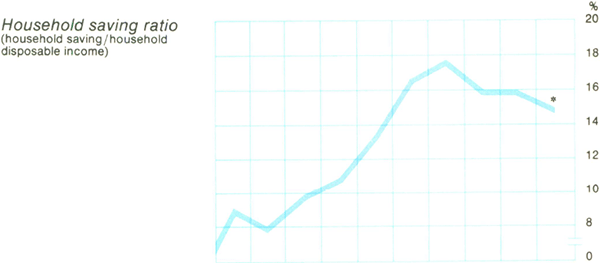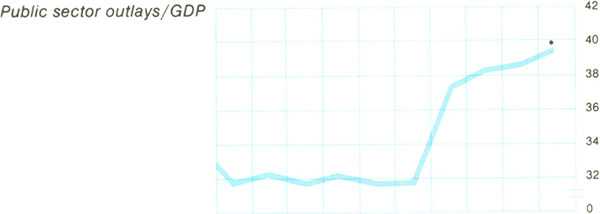Reserve Bank of Australia Annual Report – 1978 Economic Management and Monetary Policy
After the mixed performance of the economy in 1977/78, the likely extent of further improvement in 1978/79 will depend on how factors evolve in a number of important areas. Some of these are illustrated in graph 10. The data plotted there indicate the major shifts in some key economic relationships in recent years — the considerable rise in household savings, the sharp rise in labour's share of the national product, the slump in corporate profits and investment, and the rapid expansion of the public sector. While there has been a partial swing back in some areas, substantial displacements continue, and this fact makes the prediction of economic developments more than usually difficult.
With such displacements of key factors persisting, and with inflation still high enough to sustain an inflationary psychology, there is a substantial risk that a further stimulus to demand — especially from the public sector — would tend to spill over fairly quickly into higher prices, rather than lead to sustained increases in production and employment.
Some observers tend to look at the apparently low degree of capacity use, and conclude there is ample slack to be taken up, and room for more expansionary policies. But technology based on cheap energy, or on capital/labour ratios which mirror the real wage levels of a decade or so ago, has become much less profitable. Corporations will not increase production unless it is profitable to do so, nor will employers take on extra labour if labour costs are too high relative to labour's contribution to output. Although a good deal of the business investment of the last two years apparently has gone towards increasing the ratio of capital to labour as a response to the change in their relative prices, it seems that the old levels of use of productive capacity may only be regained at present with much greater pressure on prices than used to be expected.
10 Selected Ratios






The past two to three years have seen progress towards a more stable and better understood policy environment in which private decision makers can operate with increasing confidence. An element in this process has been advance indication, at Budget time, of the nature of the monetary environment which, depending to some extent on how events unfolded, was seen as consistent with the aims of policy. With this approach there was a further foreshadowed reduction, subsequently achieved, in the rate of monetary growth in 1977/78. The steady and firm winding down of the pace of monetary growth over the last three years from its earlier high levels has been accompanied by a lowering of inflation.
The situation calls for a continuation of the firm and steady approach to these matters; this is consistent with continuation of the adjustments which are necessary if the Australian economy is to move further along the path of sustainable recovery in 1978/79. The aim is to provide a monetary setting which is not accommodating to inflation, but which at the same time does not so limit the availability of funds that growth in activity is inhibited. The more quickly that expectations about growth in prices — including the price of labour — are adjusted downward, the greater the scope within a responsible monetary environment for increased output and employment.
Adequate monetary restraint cannot rely too long, and too heavily, for its attainment on a continued drain of private funds abroad. Nor is it desirable to require excessive restraint on private sector financing at home. This brings into consideration the central importance of the Commonwealth's Budget.
In present circumstances, achieving an appropriately restraining overall domestic policy environment without putting stress on the balance of payments, and on domestic interest rates, requires a balanced mix of policy in which the budget deficit is held under tight rein. The Bank's Report last year pointed to the need to contain the budget deficit in 1977/78. Despite considerable effort, the deficits of both the Commonwealth Government and the public sector as a whole were, in the out-turn, larger both in absolute terms and as proportions of national output, than in 1976/77.
The strong demand for bonds, particularly for longer maturities, helped overall policy in 1977/78. However, while continued success in containing inflation could help to maintain demand for bonds, it could be imprudent to seek to rely on such financing at the recent high levels over a longer run. The counterpart of undue ease in fiscal policy tends to be tightness in the other instruments of stabilisation policy. The scope for using monetary policy to provide some stimulus to expansion tends to be lessened, and stress on the external account can be heightened. If the setting of policies is not balanced and firm, the economic environment becomes less conducive to moderation in prices and wages setting.
The use of direct monetary controls — both those over banks and those potentially available over non-bank financial intermediaries — is sometimes seen as a way of helping to cope with the monetary effects of big budget deficits. Such an approach may be put forward as a way of helping monetary policy to achieve an immediate and limited objective, seemingly without some of the costs implicit in market-oriented policies. However, it is not clear that using direct controls will enable monetary policy to make a better fist of influencing ultimate targets, such as rates of unemployment and inflation, in any permanent way. Earlier Australian experience is that direct controls on certain channels of financing provide considerable incentive to borrowers to seek, and lenders to develop, alternative channels. In contemplating the use of direct controls, their likely costs to efficiency in financing, and to equity amongst borrowers and lenders, have to be reckoned against the benefits sought.
Over a period of a year or more, seeking to achieve a broadly stable and appropriately firm monetary environment is likely to be the most effective means of implementing monetary policy. Of course there will be short-run fluctuations of a seasonal or other nature. Markets have a substantial capacity to handle them, and it is not necessary or practicable to offset them all — indeed the effects of attempting to do so could be undesirable. Although progress has been made in Australia towards evening out the flow of government revenue and expenditure, seasonal variation is still quite large. Further attention to techniques of handling the flows may reveal scope for improvement. Some disturbances must, of course, remain, be they brief and infrequent. Efforts to moderate their effects on the price of money must recognise the longer-run objectives of monetary policy, the achievement of which requires that interest rates and exchange rates are not too sticky.
The Australian dollar exchange rate varied a good deal in 1977/78, in accord with the arrangements which had been announced in November 1976 for managing the rate in the light of all relevant economic factors. The balance of payments did not show the improvement in 1977/78 that had seemed likely early in the year; the response was substantial official borrowing overseas to augment international reserves and, to some extent, a depreciation in the value of the Australian dollar against the trade-weighted basket of currencies, the net outcome of small and frequent adjustments in the “basket rate”.
Day-to-day management of the rate had to take account of frequent severe swings in exchange rates of major currencies in overseas markets. The basket mechanism dampened their effects to an extent, and flexible management of the rate provided further scope for moderating their impact. Fluctuations experienced by most Australian traders were well within the range experienced by traders in many other countries, in a period which at times saw very heavy intervention by the authorities in those countries to stabilise exchange markets.
There have been disparities between the economic performances of major countries with inflation rates, in particular, high and widely divergent. There have also been substantial day-to-day disturbances in international currency markets. These conditions have required flexibility in exchange rates. One major lesson from recent international experience is that, regardless of the exchange rate techniques that are in use, a vital factor in external viability is the maintenance of sound domestic policies.
The lowering of inflation through 1977/78 helped to provide the conditions for some reductions in interest rates in Australia, particularly for longer terms. Sometimes the interest rate reductions seemed to run ahead a little, but with inflation moderating, the cuts proved to be sustainable. The manner in which the interest rate reductions occurred was important. A succession of small cuts in bond yields, supported by the evidence on inflation and set against statements of political intent, engendered renewed strong expectations of further falls in yields. The desire of investors to build inventories of long bonds tended to keep up the level of short rates; the drain of funds overseas worked to the same end. In the event, the reductions in interest rates were achieved in the context of more restrained monetary growth.
With the economy taking time to adjust, and monetary policy necessarily firm, some have looked for more rapid monetary expansion as a way to further and more general interest rate reductions, with the hope in particular of providing stimulus to home building and business investment. Higher activity is indeed to be desired, as, despite improvement in performance on inflation, unemployment has risen, and there is a proper concern not to prolong avoidably the wastes that entails. However, with inflation still high by historical standards, and its conquest not beyond doubt, unduly rapid monetary expansion could quickly be perceived as a threat of higher inflation in the future, with adverse effects on activity and employment.
In the long run the scope for interest rate reductions is closely related to what is sustainable in terms of lower inflation. Should asset holders cease to be convinced that lower interest rates are sustainable, expectations could change, perhaps abruptly, and upward pressure on interest rates could emerge. It is worth recalling that from the mid 1950s through to the end of the 1960s inflation in Australia averaged about 2½ per cent per annum, while the long-term bond rate hovered around 5 per cent. Interest rates and price changes have only recently moved towards re-establishing that sort of relativity.
Although additional inroads into inflation would be a factor tending to provide scope for easing some of the settings of monetary instruments, the achievement of an appropriate mix of policies will depend mainly on adequately containing the deficit of the public sector. Such a policy mix will need to continue to have high regard for the need to combat inflation. The hope is that it will provide, within Australia, a foundation for the patient exercise of the skills and resourcefulness on which, particularly in the absence of a general substantial boost from overseas economic developments, a solid recovery depends.